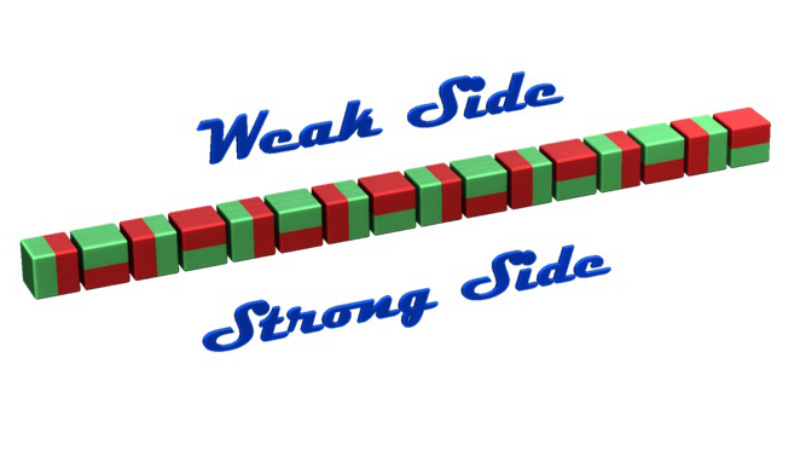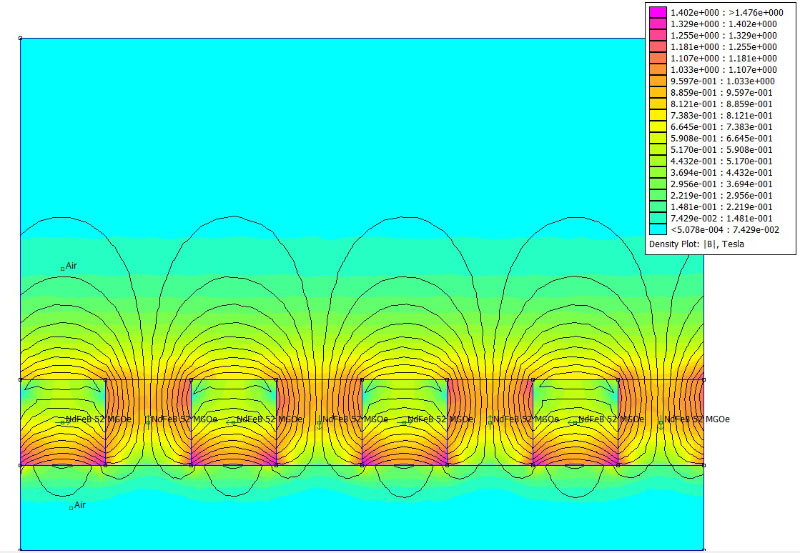What Is The Pull Force of A Magnet?
A magnet’s pull force is the force it exerts on other magnetic materials, such as iron or steel. This force is typically measured in units of pounds or newtons.
Methods To Increase The Magnetic Pull Force?
The strength of a magnet’s pull force can be crucial in specific applications. Following, we will explore some methods that can be used to boost a magnet’s pull force.
Magnet Itself
Grade: The grade of a magnet refers to its magnetic strength or the strength of its magnetic field. Magnets with higher grades typically have stronger magnetic fields and can produce stronger forces, so using a magnet with a higher grade can increase the pull force. For example, a magnet with a grade of N52 will produce a stronger force than a magnet with a grade of N35. This is because the N52 magnet has a higher magnetic strength and can generate a stronger magnetic field.
Size: The size of a magnet can affect its pull force in two ways. First, larger magnets will have a greater surface area, which means they can produce a stronger force. This is because a larger magnet can interact with more of the magnetic field of the object it attracts, allowing it to generate a stronger force. Second, larger magnets also typically have more mass, which means they can produce a stronger force due to the principle of conservation of energy. In general, using a larger magnet can increase the pull force.
Shape: The shape of a magnet can affect its pull force in several ways. First, shaping the magnet into a more elongated or streamlined shape can help it focus its magnetic field and produce a stronger force. This is because a focused magnetic field is more powerful than a diffuse one, so a magnet with a focused field can generate a stronger force. Second, shaping the magnet into a specific shape can also help it better interact with the magnetic field of the object it is attracting, allowing it to produce a stronger force. For example, if the object you are trying to attract has a specific shape, you can shape your magnet to match that shape to increase the pull force.
Attaching Object
Object Material: Several factors can affect the pull force of a magnet when it comes into contact with another object. The material of the object that the magnet is in contact with can significantly affect the pull force. For example, a magnet typically has a stronger pull force on ferromagnetic materials, such as iron or steel, than on non-magnetic materials, such as aluminum or copper.
Object Surface: The surface of the object that the magnet is in contact with can also affect the pull force. A smooth, flat surface typically allows the magnet to make better contact with the object, resulting in a stronger pull force. A rough or uneven surface, on the other hand, can reduce the contact area between the magnet and the object, resulting in a weaker pull force.
Object Thickness: The thickness of the object the magnet is in contact with can also affect the pull force. In general, the thicker the object, the more difficult it will be for the magnet to penetrate it, which can reduce the pull force.
Contact Area: The contact area between the magnet and the object can also affect the pull force. A larger contact area typically results in a stronger pull force, while a smaller contact area will result in a weaker pull force.
Air Gap
The air gap can affect the magnet’s pull force. As the distance between the magnet and the object being pulled increases, the pull force will decrease. This is because the magnetic field strength decreases with distance, so the further the magnet is from the object, the weaker the magnetic force will be. Reducing the air gap between the magnet and the object can increase the pull force.
Halbach array Design
A Halbach array is a specific arrangement of magnets that can increase a magnet’s pulling force. The array is named after its inventor, Klaus Halbach, who developed the concept in the 1970s.
In a Halbach array, the magnets are arranged in a specific pattern to create a strong magnetic field on one side of the array while canceling the field on the other. This creates a highly focused magnetic field that can increase the pulling force of the magnet.

To create a Halbach array, the magnets are typically arranged in a circular or rectangular pattern, with the north and south poles of the magnets oriented in a specific way. This creates a strong magnetic field on the side of the array where the poles are oriented in the same direction and a weaker or canceled-out field on the other side.

The advantage of using a Halbach array is that it can increase the pulling force of a magnet without increasing its size or weight. This makes it useful in applications where a strong magnet is needed but space or weight is limited.
Overall, there are several ways to increase the pulling force of a magnet, and the best approach will depend on the specific application and the type of magnet being used. Whether you use a stronger material, increase the size of the magnet, use multiple magnets, decrease the distance between the magnet and the object, or employ a ferromagnetic material, you can improve the performance of your magnet and achieve your desired results.
Does Stacking Magnets Increase Pull Force
Yes, stacking magnets can increase the pull force. When magnets are stacked, their fields combine and add to the overall magnetic field, making them more powerful and increasing the pull force. However, the increase in pull force will depend on the type and orientation of the stacked magnets.
In some cases, stacking magnets may not increase the pull force at all, or it may even decrease the pull force. It’s best to experiment with different configurations to see what works best.
How Is The pull force Of A Magnet Measured
The pull force of a magnet is typically measured using a device called a magnetic pull force tester. This device consists of a spring scale used to measure the force and a clamp that holds the tested magnet. To measure the pull force of a magnet, the magnet is attached to the clamp and then brought into contact with a piece of iron or steel. The force required to separate the magnet from the iron or steel is measured using the spring scale, and this force is reported as the magnet’s pull force. This measurement is typically reported in units of pounds or kilograms.

How are “Gauss” and “Pull Force” Related?
Gauss and pull force are not directly related. Gauss is a unit of measurement used in physics to describe the strength of a magnetic field, while pull force refers to the amount of force required to move an object. These two quantities are not directly related and cannot be used interchangeably.
To understand the relationship between these two quantities, it’s helpful first to understand the concept of magnetic field strength. A magnetic field is a region around a magnet or electric current with a force on other magnets or charged particles. The strength of a magnetic field is typically measured in units of Gauss.
On the other hand, pull force is the force required to move an object. Many things, including gravity, friction, and magnetism, can cause this force. In the case of magnetism, the pull force is determined by the magnetic field’s strength and the magnet’s or magnetic material’s type and size.
In summary, Gauss and pull force are not directly related, but the strength of a magnetic field, measured in Gauss, can affect the pull force exerted by a magnet.
Magnetic Calculators
Knowing the magnetic field strength of a magnet can help determine its suitability for a particular application.
For example, a magnet with a higher magnetic field strength can exert a greater force on other magnetic materials, making it more suitable for applications requiring a strong magnetic force.
On the other hand, a magnet with a lower magnetic field strength may be more suitable for applications where a weaker magnetic force is sufficient.
Using a magnetic calculator, such as JdaMagnet.com, customers can quickly determine the magnetic field strength of different magnets and compare them to find the one best suited for their needs.
Choosing The Right Magnet
When choosing the right magnet for a particular application, several factors must be considered. JDA Magnets may be able to provide more information and assistance in choosing the right magnet for a specific application.
